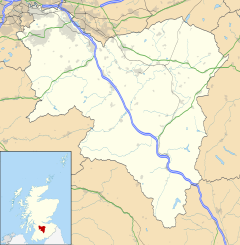Dunsyre
Dunsyre(Scottish Gaelic:Dùn Saghair) is a village inSouth Lanarkshire,Scotland. It is 10 kilometres (6 mi) fromCarnwath.Dunsyre is associated with an ancientbaronyandparish church.The name of Dunsyre is ofCelticorigin and is supposed to signify the "Hill of the Seer."[dubious–discuss]It is located by the burn known as theSouth Medwin Water.
From 1867 until 1945 Dunsyre was served by a railway branch from Carstairs toDolphinton,originally built by the Caledonian Railway, and the disused embankment of this runs along the south side of the village close to the church.[1]
The surface is generally elevated, and rises further still into the surrounding hills. Dunsyre Hill overlooks the area from the north and Blackmount from the south. Dunsyre Hill forms the termination of thePentland Hills,a range extending for nearly 32 km (20 mi) from the immediate vicinity ofEdinburgh.This hill has an elevation of 150 metres (500 ft) above the general surface of the lands, and of 401 metres (1,315 ft) above sea level; a small range of gradually diminishing hills branches off towards the west from it, stretching to the parish ofCarnwath.Between the Dunsyre andWalstonranges is a level valley about 5 km (3 mi) in length and 1.6 km (1 mi) wide. The small river of theSouth Medwinruns along the valley, eventually joining the river Clyde. The ornamental gardenLittle Spartalies immediately to the west of the village.
-
Black Mount
Black Mount (516 m or 1,693 ft) looking over Dunsyre and the South Medwin Valley -
Westhall Tower
The remains of the 16th-century tower at Westhall Farm, Dunsyre. Originally built in thePeel towerstyle.
References
[edit]- ^Railway Passenger Stations of England, Scotland and Wales: A Chronology; M.E. Quick; Railway & Canal Historical Society, Richmond, Surrey; 2005.
External links
[edit]- "Dunsyre" - geo.ed.ac.uk
- Dunsyre and Dunsyre.netInformation about Dunsyre and local links.



